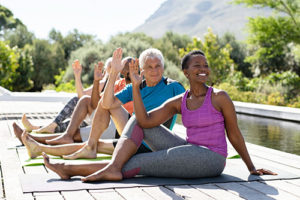The past three months have been stressful for everyone. The many uncertainties surrounding COVID-19 along with, at times, conflicting reports can take an emotional toll. We are still in the midst of a global pandemic though certain areas have started to cautiously reopen. Numerous variables are still unknown like how prepared we are for a second wave? How might it impact us or how long will it take to develop a vaccine?
It’s okay to acknowledge that many of us feel challenged and tensed. It is a normal human response. But we are not powerless! The current situation might last a while. To better cope in the long run, we should try to manage stress by limiting our time watching TV, listening to the radio or following news on social channels. Stay informed once or twice a day with a reliable news source, adhere to official distancing rules and focus on self-care and what feels right to you. Luckily, we can now take advantage of the nice weather and encouraging sun rays to get started.
SOME IDEAS ON HOW TO RELIEVE STRESS AND PROMOTE WELL-BEING
- Petting an animal has relaxing and therapeutic benefits to humans. It increases the release of feel-good endorphins and may lower your blood pressure and improve your overall health.
- Reduce your caffeine intake. Caffeine is a powerful stimulant and a moderate consumption of it can bring both health benefits (beside keeping you alert and energized) and negative effects. Consuming over 400 mg of caffeine a day can lead to uncomfortable symptoms like: elevation of blood pressure and/or stress hormone levels, irritability, headaches, disrupted sleep, nervousness, anxiety or magnified perception of stress. The definition of moderate intake may vary from person to person, so it is important to monitor your current daily intake and watch for jitters and shakes or any of the listed sig ns and try to adjust accordingly.
- Laughter as a therapy? It’s no joke! Did you notice that you can’t feel anxious while you’re laughing? It’s a simple good tool to relieve stress response and relax your muscles. Studies revealed that humor has multiple short- and long-term benefits and is one of the most frequently used complementary therapies with cancer patients. In addition to its established psychological benefits, laughter may have physiological effects on the immune system, encourages the body to produce natural painkillers and improves your mood and sense of well-being. Try watching a funny TV show or hanging out with people who make you laugh.
- Exercise & Nutrition. It has long been proven that exercise helps lower your body’s stress hormones and release endorphins, which are chemicals that improve your mood and act as natural painkillers. It can also improve sleep quality, otherwise negatively affected by stress and anxiety.
The type of recommended exercise and nutritional modifications do vary according to ages. We tried to summarize a few suggestions per life decade.
In your 20s
At this age your body is at its peak and extremely adaptable, so consider cross-training by combining both anaerobic (strength/resistance training) with aerobic (cardio) elements. Be sure to incorporate weight training twice a week, cardio three to five days a week, balance work, and stretching. Vary your routine and keep it fun.
Nutrition Tip: We build bone well into the mid-20s so focus on calcium, folate, iron (dairy, fortified non-dairy beverages such as soy, rice and almond milks, calcium-fortified juices, green vegetables, salmon, almonds, tahini). Women who plan to get pregnant may add B vitamin and folic acid supplements.
In your 30s
Priorities often shift in our 30s and career and family obligations leave less time for exercise.
At the same time muscle mass and strength begin their steady decline – but you can slow that process. People lose strength faster than they lose muscle, therefor strength training (at least twice a week) can offer a good remedy. High-intensity interval training combining flexibility work, strength work, and cardio can keep you fit. It is a good point in time to start keeping an eye on your daily steps/stairs count, while trying to squeeze fitness (some squats, push-ups or taking the stairs) into your demanding schedule.
Nutrition Tip: The body’s metabolism and calorie requirements begin to decline. Cut down starchy (processed) foods, continue to consume foods rich in calcium, folate, and iron, and focus on magnesium (helps regulate blood pressure and blood sugar and maintain strong bones).
In your 40s
With age, bone density, strength, and muscle mass tend to decline. At this point you can expect your performance to plateau and recovery to take a bit longer no matter what your sport of choice is. Sedentary jobs can have significant effects after a decade or two and our back, neck, hips, and knees begin to tighten. By now you might have broken your training habit a few times and the best way to get back at it is to forgive yourself and try out new types of activity. How about dance, martial arts, or outdoor exercise? All of those can help mix things up and lift up your spirit. Slow down the natural progression by adding 2-3 a week strength training exercises to your moderate-intensity cardio routine. Try to develop strength-building activities you can practice and improve for the long run like hiking. Pilates and Feldenkrais can help building core strength to protect against back pain.
Nutrition Tip: Start preparing for the coming decades by making nutrient-dense food choices and including antioxidants. Sources of vitamin C: red and green pepper, citrus fruit, kiwi, broccoli, Brussels sprouts, strawberries and tomato juice. Vitamin E: almonds, sunflower oil, hazelnuts, peanut butter, and sunflower seeds. Other recommended antioxidants include beta-carotene (e.g., carrots, sweet potato, apricots, green vegetables) and selenium (e.g., Brazil nuts, tuna, shrimp, turkey).
In your 50s
At 50, though you might have accumulated a few injuries or receive reminders of chronical conditions from time to time, often, telling yourself that “you’re over the hill” may hurt you more than the training you are missing. Leisurely pursuits are wonderful, but it will not be sufficient if you don’t break a sweat. Generally, when people include high-intensity interval training, their cardio health remains high. However, consult your doctor before starting a demanding routine and allow for more recovery time between workouts. Listen to your body; some may opt for high-intensity interval training only once a week vs. multiple times. Weight-bearing exercises, such as fast walking (5 days a week), and resistance training – primarily for hips and shoulders – are recommended to improve bone density and slow the loss of lean body mass.
Nutrition Tip: women often benefit from calcium intake of 1,200 mg a day. After 50 both genders should supplement with vitamin B12 (supports production red blood cells, nerves and DNA) and vitamin D. With age our capacity to produce vitamin D through sun exposure decreases. The official recommended dietary allowance for vitamin D of from 600 IU increases to 800 IU (in your 70s), though many experts recommend an intake 1,000 to 2,000 IU each day after 50.
In your 60s
Maintaining a high level of physical activity can help prevent several types of cancers and post-menopausal conditions. It helps reducing the risk of developing chronic conditions, such as heart disease and type 2 diabetes. Do what you can to maintain your physical condition and independence. Keep a routine of brisk walking a few times a week (or mix it up with swimming), attend a Pilates and/or Yoga class (1-2 times a week), and aim to squeeze a few bodyweight exercises in between (e.g. sit-ups, push-ups, or wall sits). Taking up social activities like ballroom or Zumba dancing can be physically beneficial and a lot of fun.
In your 70s
If your health allows, you can continue with strength and balance training, hiking, cardio, or slightly lower-impact activities — as long as you pace yourself, monitor your body response, and adjust accordingly. If you suffer from any chronical conditions consult with a physiotherapist or other exercise professional first. During and after our 70s, exercise supports our cognitive function (why not take up Tai Chi?) and helps prevent falls.
In your 80s, 90s and beyond
Any activity you consistently do will benefit your body and mind. By now, while almost everyone has physical limitations and aches, too much rest may do more harm than good and can lead to loss of strength and endurance or weaken your cardiovascular system. Resistance and balance training are crucial to reduce fall risk and guided weight training may reduce the need for walkers and the likelihood of cognitive decline and Alzheimer’s. Your muscles, joints, and entire body remain adaptable so find an activity you enjoy without risking injury and stick to it – you’d be surprised at the results!
Do not forget to take the time to stretch and decompress after exercising at any age, adapt your nutritional intake to match your needs as you grow older, and from your 20s to any later stage of your life be aware of harmful little habits we tend to pick up along the way, try to shake them off and maintain a healthy lifestyle simply by following moderation.


